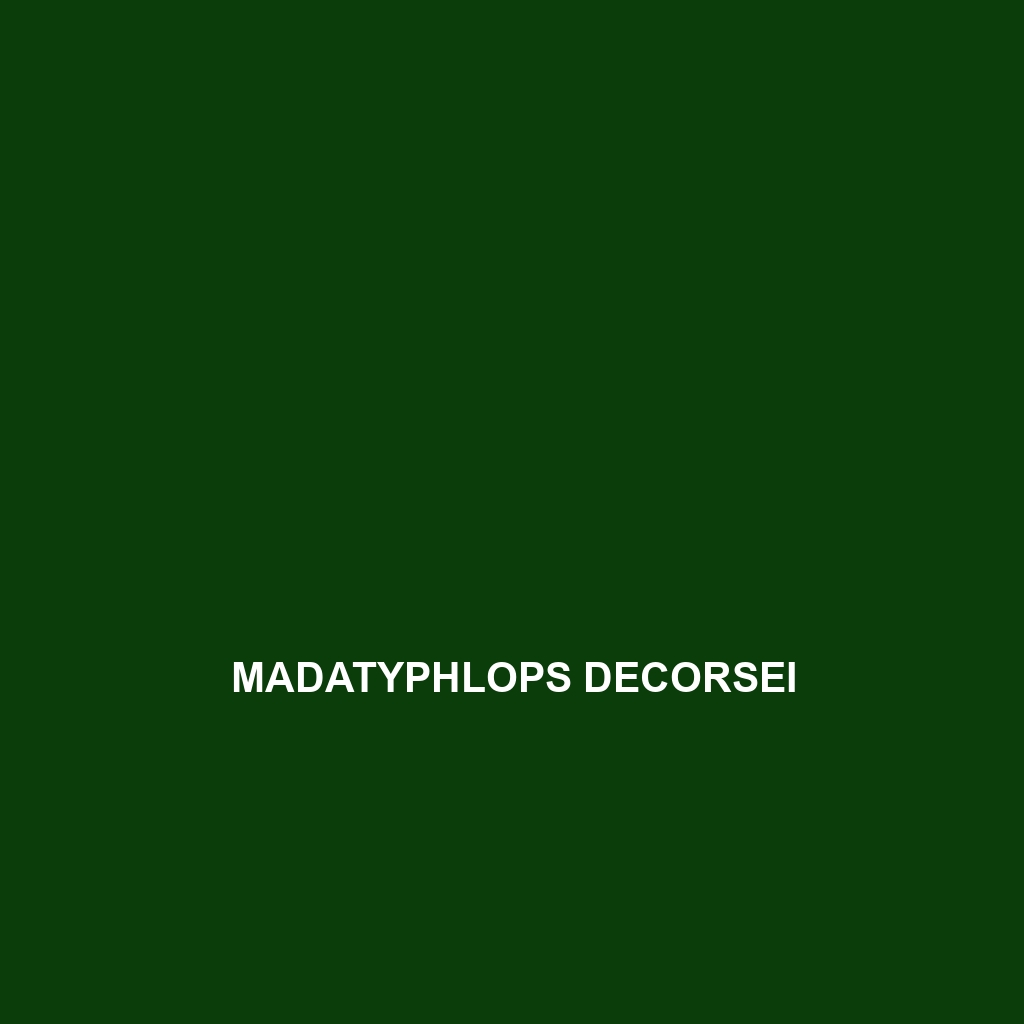Common Name
Madatyphlops decorsei
Scientific Name
Madatyphlops decorsei
Habitat
Madatyphlops decorsei, commonly known as Decor’s blind snake, primarily inhabits the tropical environments of the Madagascar region. This species thrives in rainforests and savannas where high humidity and ample cover are provided by leaf litter and organic debris. The habitat is characterized by a warm climate, with temperatures often exceeding 25°C (77°F) during the day and cooler nights. These snakes prefer soil with abundant moisture, perfect for burrowing and hiding from predators. Their habitat ensures a rich diversity of invertebrate prey, essential for their diet.
Physical Characteristics
Madatyphlops decorsei is a fascinating creature, easily recognizable by its elongated, cylindrical body that can reach lengths of up to 60 cm (24 inches). The coloration ranges from a pale tan to a deeper brown, often with lighter bands or spots that provide effective camouflage against the forest floor. Their shiny, smooth scales are a distinguishing feature, allowing them to easily navigate through their underground habitats. Unlike many of their counterparts, Madatyphlops decorsei display a secondary sexual dimorphism – males are generally smaller than females, which can influence their mating behavior and territory sizes.
Behavior
This species exhibits primarily nocturnal behavior, emerging at night to hunt for its prey. They are solitary creatures but are known to display interesting social interactions during the breeding season, where males may engage in combat displays to attract females. Their burrowing habits are noteworthy; they dig intricate tunnel systems that provide shelter and serve as feeding grounds. Madatyphlops decorsei is non-vocal and relies on its keen sense of smell and vibration detection for communication, adding to its intriguing behavioral repertoire.
Diet
Madatyphlops decorsei is classified as an insectivore, primarily feeding on a diet of soft-bodied invertebrates such as earthworms and larvae. Their foraging behavior involves slowly navigating through the soil, using their sensitive snouts to locate food. The species has adapted to consume its prey whole, with no need for chewing. This dietary preference makes them an integral part of their ecological niche, controlling the population of various invertebrate species.
Reproduction
The reproductive cycle of Madatyphlops decorsei is relatively little-known, though it is believed that mating occurs during the warm months following the rainy season. After successful copulation, females lay a clutch of up to five eggs, which are incubated in the warm, moist environment of the soil. The gestation period lasts approximately two months, after which the hatchlings emerge fully formed and independent. Parental care is not observed in this species, indicative of an evolutionary strategy that emphasizes high fecundity over offspring survival.
Conservation Status
The conservation status of Madatyphlops decorsei is currently listed as vulnerable according to the IUCN Red List. Habitat destruction due to deforestation and land conversion into agriculture poses significant threats to their populations. Conservation efforts are essential to maintain their habitat and mitigate the impacts of climate change, which further threatens their survival. Organizations working in Madagascar have initiated programs aimed at habitat preservation and restoration, highlighting the need for sustainable practices in local communities.
Interesting Facts
One of the most intriguing aspects of Madatyphlops decorsei is its unique adaptation to a life spent entirely underground. Their reduced eyes, which are covered by scales, serve no purpose for vision but enable them to navigate through their subterranean environment effectively. Additionally, these snakes can consume prey larger than their head due to the elasticity of their jaws, a fascinating evolutionary adaptation. The Decor’s blind snake is often an overlooked species in biodiversity studies, despite its crucial role in maintaining the ecological balance in its native habitats.
Role in Ecosystem
Madatyphlops decorsei plays an essential role in its ecosystem as both a predator and prey. By controlling populations of invertebrates, they help maintain the soil’s health and nutrient cycling. Furthermore, they serve as food for larger predators including birds and mammals. Their burrowing activity aerates the soil, promoting plant growth and enhancing the overall biodiversity of their rainforest and savanna habitats. As such, they could be considered a keystone species, highlighting their importance in maintaining ecological stability.
